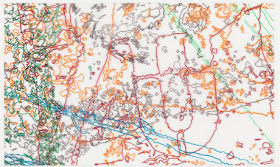Tuesday, 23 August 2011
Jim Dine Hearts
I've had this project in my 'workshop ideas' folder for a few months now after seeing it on For The Love of Art blog. I was saving it for a Valentines project but then I decided that there's no reason for love hearts to be seasonal and, besides, who knows what I'll be doing in 6 months time? I started the class by showing everyone this picture:
The bright colours really appealed to my students and they were immediately enthusiastic about the project. I handed out sheets of black paper and initially got them to choose one colour of pastel. After they had added some colour, I got them to swap pastels with their neighbours until they had used a few colours. I then went round everyone individually, folding their paper and drawing half a heart for them (or their carers) to cut out. Once these were done and put aside, I gave out larger sheets of yellow paper and small squares of coloured tissue and glue. I asked them to concentrate on gluing the squares around the outside of the paper because we would be sticking the heart in the middle. They all followed this instruction ok. I made sure everyone's squares were stuck down properly before they glued the heart into the centre. Some students almost spoiled their pictures at the last minute by starting to paint glue on top of their heart or by using gluey fingers to press it down - next time I would warn them in advance about that! They all seemed happy with their creations anyway.
Monday, 15 August 2011
Ingrid Calame
I was through at the Edinburgh Festival last week and stumbled across an exhibition by New York artist Ingrid Calame. She makes art by tracing marks and stains she finds on the ground - sounds crazy but her drawings are really beautiful! She uses sheets of architectural Mylar (top quality tracing paper) to trace marks on the ground such as stains, cracks and graffiti which she takes back to her studio and re-traces using coloured pencils. She layers up the sheets of traced drawings to create what she calls a 'constellation', like the example above.
Tracing paper? Coloured pencils? I feel a workshop coming on......
Thursday, 11 August 2011
Bird's Nest Collage
I got the idea for this lovely project from the Adventures of an Art Teacher blog.
I had not used the technique of blowing thinned paint through a straw with my class of disabled adults before and was sure that they would find it fun. After handing out the paper I went round each student individually and spooned a teaspoon of paint onto their paper and instucted them to blow (not suck!) the paint towards me. Not all of them managed to blow through the straw successfully but tilting the paper to let the paint run also worked well, as did using the straw like a brush to move the paint around. All of their 'tree branches' looked fantastic and very individual. I then showed them how to draw a few leaves at the end of the twigs they had just created. The paint was of course still very wet and I asked them to try not to dip the pastels into the wet paint. When I cleaned up at the end only one pastel had brown paint on it! Most of them needed help from their carers to draw and cut out some egg shapes from patterned paper. I asked them to place the eggs on the picture and let me check it before glueing them down as there was a temptation to spread the eggs all over the branch istead of grouping them together. I then handed out some shredded newspaper and pieces of raffia which they glued down to make the nest. The final step was to use a blue pastel to give the suggestion of a blue sky. I thought that we might have time to draw a bird sitting on the branch too but the activity took up the whole hour quite easily.
Tuesday, 2 August 2011
Paper Plate Radial Weaving
Thanks to Mr E and Mrs Jahnig for this idea.
Most of the projects I do with my regular class are paper-based so it's nice to occassionally do some textile art. Radial weaving is new to me (and my students!). When I tried it out at home I realised that my class of disabled adults would probably find it quite fiddly as you need quite nimble little fingers to weave the wool in and out. I almost abandoned the project but then hit upon the idea of cutting out the centre of the plate. This makes it much easier to pass the wool in and out.
When I came to do the project in class, I had pre-strung all the looms (paper plates) so that they could start weaving right away. I encouraged them all to use plastic sewing needles to make the wool even easier to handle.
The class all managed this activity quite well. A couple of students wanted to do their own thing and happily sewed the wool randomly in and out, ending up with something of a tangled mess but a sense of satisfaction at having done it their way!
Once they had been weaving for about 35 minutes I gave them the choice of leaving their work on the loom for display (when I strung the looms I left a loop for hanging) or taking it off. They all wanted to leave it on so I handed out oil pastels so that they could decorate the edges of the plates.











